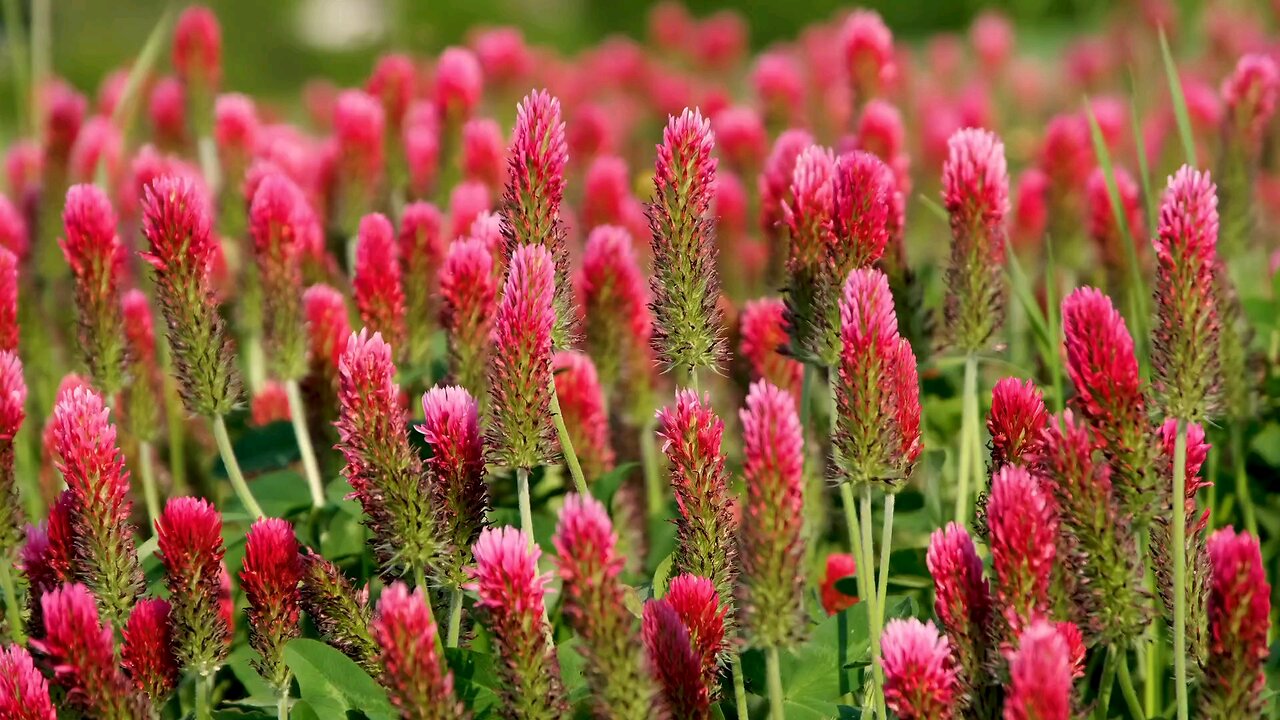Premium Only Content

"Red Clover (Trifolium pratense): Vibrant Blooms and Benefits"
Red clover (Trifolium pratense) is a perennial herbaceous plant belonging to the legume family (Fabaceae). It is native to Europe, Western Asia, and northwest Africa but has been widely naturalized in many other regions, including North America.
### Characteristics
- **Appearance**: Red clover has a characteristic pinkish-red flower head composed of numerous small, tubular florets. Its leaves are trifoliate, meaning they have three leaflets, often with a pale, crescent-shaped mark.
- **Growth**: It typically grows to a height of 20-80 cm and thrives in a variety of soils, especially well-drained, loamy soils. Red clover is often found in fields, meadows, and along roadsides.
- **Lifecycle**: It is a short-lived perennial, often surviving for 2-3 years.
### Uses
- **Agricultural**:
- **Forage Crop**: Widely used as livestock fodder due to its high protein content and palatability.
- **Cover Crop**: Helps in soil improvement and management, as it fixes nitrogen, improving soil fertility.
- **Crop Rotation**: Used in crop rotation systems to reduce soil erosion and improve soil structure.
- **Medicinal**: Red clover is known for its phytoestrogens, which are compounds that mimic estrogen in the body. It is used in traditional medicine for:
- **Menopausal Symptoms**: Alleviating hot flashes and other menopausal symptoms.
- **Skin Health**: Treating skin conditions like eczema and psoriasis.
- **Cardiovascular Health**: Supporting heart health by improving circulation and reducing blood pressure.
- **Culinary**: Though less common, the flowers and leaves can be used in salads or as a garnish. They are also sometimes used to make herbal teas.
### Environmental Benefits
- **Biodiversity**: Red clover provides a habitat and food source for various pollinators, including bees and butterflies.
- **Soil Health**: Enhances soil structure and fertility through nitrogen fixation and organic matter addition.
### Cultivation
- **Planting**: It is usually sown in early spring or late summer. It requires adequate sunlight and moderate watering.
- **Maintenance**: Minimal maintenance is required once established, but periodic mowing can encourage denser growth.
### Challenges
- **Pests and Diseases**: Susceptible to root rot, powdery mildew, and various pests like aphids.
- **Invasiveness**: While beneficial, it can sometimes become invasive in non-native regions, outcompeting local flora.
Overall, red clover is a versatile and valuable plant in agriculture, medicine, and environmental management.
-
 47:47
47:47
Athlete & Artist Show
6 hours agoSeason 6 Premiere, NHL Season Preview!
519 -
 17:17
17:17
Advanced Level Diagnostics
19 days agoWhy won't this Mack Truck Charge!
344 -
 1:33:51
1:33:51
Steve-O's Wild Ride! Podcast
16 days ago $10.57 earnedJohn C. Reilly's Surprising Connection To Jackass (And Beef With Weeman!)
98.5K21 -
 LIVE
LIVE
StoneMountain64
2 hours agoBattlefield 6 Unlocks and Challenges
38 watching -
 LIVE
LIVE
Total Horse Channel
10 hours agoLow Roller Reining Classic | Main Arena | October 11th, 2025
180 watching -
 LIVE
LIVE
GamerGril
3 hours agoZombie Fight Club 💞Dying Light The Beast💞
93 watching -
 56:25
56:25
MentourPilot
1 year agoTITANIC of the Skies! - The Untold Story of Air France 447
35.8K6 -
 LIVE
LIVE
Lofi Girl
2 years agoSynthwave Radio 🌌 - beats to chill/game to
249 watching -
 2:07:47
2:07:47
LFA TV
18 hours agoTHE RUMBLE RUNDOWN LIVE @9AM EST
81.9K12 -
 2:20:46
2:20:46
I_Came_With_Fire_Podcast
12 hours agoThe Pattern Beneath the World: Nature, The Mark of the Beast, & the Sacred Order
28.2K25